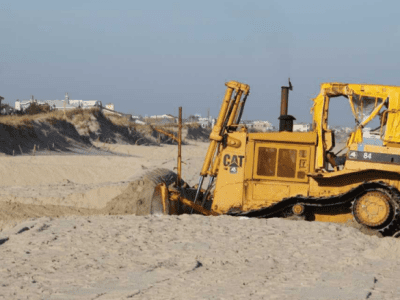TWO VIEWS FROM THE USA: Dune protection and beach access

(Photo source: Emma Lee/for NewsWorks, file)
Last week I read two articles from the USA that made me think of where we are heading in Australia—some might argue we are already there!
The first article is from New Jersey; the title of this article in brief says ‘’ Condemnation proceedings imminent if holdouts don’t sign’’. The point made was that the state of New Jersey will go after more oceanfront property owners if they refuse to sign easements that would allow the construction of protective sand dunes to hold back storm surges. This applied to an area around Mantoloking which was severely hurt by the ravages of Super-hurricane Sandy in October 2012. The state plans to file court motions to seize beachfront land strips if property owners do not comply. Up to 10 owners out of 128 at this location are refusing to allow the government to build sand dunes on a portion of their land. Statewide there are 239 easements that are outstanding. In some cases local governments are resisting the eminent domain claims of the state arguing that wooden bulkheads are sufficient to protect against ocean flooding. Some landowners, however, have in the words of the State Attorney General, ‘’unselfishly donated easements for the greater good rather than engage in protracted litigation’’. The message coming from the state government is clear: stretches of the New Jersey coast need protective sand dunes to protect against surges such as occurred with Sandy and people who object may have to sacrifice their views of the sea and access privileges.
In Australia we have cases where local authorities bow to the wishes of beachfront residents or surfing organisations or anti-native vegetation folk. The purpose of these groups is to lower dune crests, or remove or not allow foredune native vegetation to grow to form a natural buffer against the sea. Just as in New Jersey, many of us recognise the protective role that foredunes play in limiting wave erosion and storm surges. Moreover, there are many in the Dunecare movement who see the importance of foredune biodiversity that accompanies the construction and then reconstruction of foredunes after extreme storm events. It is certain that in the future foredunes along our coast will be damaged by waves; that is part of a beach/dune system. But the role they play is critical and the experience of New Jersey is informative; good public policy requires us to nurture and assist vegetative growth on foredunes, not allow them to be killed by some local lobbying. It will be a continual process demanding actions from state, local and community organisations to look after our foredunes.
The second article is from California entitled ‘’Public beach poached for private privilege”. In one sense this is a more worrying article because it reveals the impotence of the public authorities to intervene for the public good. The heart of the California’s Coastal Act is its requirement that development not interfere with the public’s right to access the beach. But landowner’s are building seawalls and other structures on top of publicly owned beaches causing a loss of beaches as seen at Broad Beach, Malibu. As put by one of the California Coastal Commissioners: ‘’seawalls kill beaches”. The Broad Beach case has involved homeowners hiring security guards to remove the public off the beach as well as undertake unpermitted ‘’works’’ on public trust lands that result impede public access. Landowners even refused a compromise pedestrian path on the landward side of a revetment that offered both property protection and access along the foreshore. The article concludes by saying “ As sea levels continue to rise and storms bludgeon the coast with increasing force, the conflict between public access and protecting public property will only worsen in California…. The public deserves to be compensated for using public lands to protect private property’’.
In reflecting on the Californian article, I am quite concerned about how we In Australia can best avoid such problems arising on a large scale. We know there are places today where claims of private ownership of beach and foredune land is causing problems. The presence of illegal dumping of rocks, car bodies and other objects to prevent erosion events from adversely impacting on property extent is not that unusual. The issue of trespass on the active beach has been tested in a few places. We can expect issues outlined in the second article to occur in the future just as we can with the destruction of foredune vegetation with or without local consent. The overarching question is how best to defend the long-term public good. Clearly it is not an easy question to answer in the highly contested space that is our coast.
– words by Prof Bruce Thom


 Annual General Meeting (AGM) of the Australian Coastal Society
Annual General Meeting (AGM) of the Australian Coastal Society